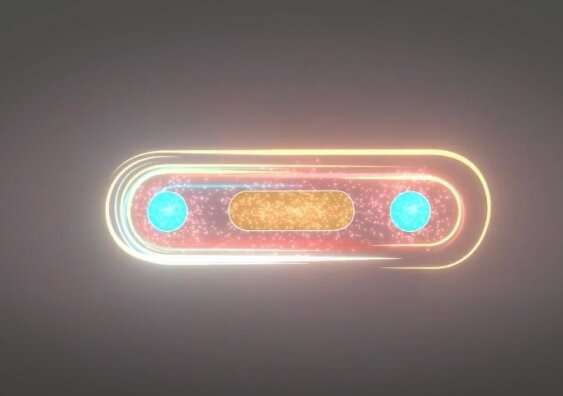This article has been reviewed according to Science X's editorial process and policies. Editors have highlighted the following attributes while ensuring the content's credibility:
fact-checked
peer-reviewed publication
trusted source
proofread
Jellybeans: A sweet solution for overcrowded circuitry in quantum computer chips

The silicon microchips of future quantum computers will be packed with millions, if not billions of qubits—the basic units of quantum information—to solve the greatest problems facing humanity. And with millions of qubits needing millions of wires in the microchip circuitry, it was always going to get cramped in there.
But now engineers at UNSW Sydney have made an important step toward solving a long-standing problem about giving their qubits more breathing space—and it all revolves around jellybeans.
Not the kind we rely on for a sugar hit to get us past the 3pm slump. But jellybean quantum dots—elongated areas between qubit pairs that create more space for wiring without interrupting the way the paired qubits interact with each other.
As lead author Associate Professor Arne Laucht explains, the jellybean quantum dot is not a new concept in quantum computing, and has been discussed as a solution to some of the many pathways toward building the world's first working quantum computer.
"It has been shown in different material systems such as gallium arsenide. But it has not been shown in silicon before," he says.
Silicon is arguably one of the most important materials in quantum computing, A/Prof. Laucht says, as the infrastructure to produce future quantum computing chips is already available, given we use silicon chips in classical computers. Another benefit is that you can fit so many qubits (in the form of electrons) on the one chip.
"But because the qubits need to be so close together to share information with one another, placing wires between each pair was always going to be a challenge."
In a study published today in Advanced Materials, the UNSW team of engineers describe how they showed in the lab that jellybean quantum dots were possible in silicon. This now opens the way for qubits to be spaced apart to ensure that the wires necessary to connect and control the qubits can be fit in between.
How it works
In a normal quantum dot using spin qubits, single electrons are pulled from a pool of electrons in silicon to sit under a "quantum gate"—where the spin of each electron represents the computational state. For example, spin up may represent a 0 and spin down could represent a 1. Each qubit can then be controlled by an oscillating magnetic field of microwave frequency.
But to implement a quantum algorithm, we also need two-qubit gates, where the control of one qubit is conditional on the state of the other. For this to work, both quantum dots need to be placed very closely, just a few 10s of nanometers apart so their spins can interact with one another. (To put this in perspective, a single human hair is about 100,000 nanometers thick.)
But moving them further apart to create more real estate for wiring has always been the challenge facing scientists and engineers. The problem was as the paired qubits move apart, they would then stop interacting.
The jellybean solution represents a way of having both: nicely spaced qubits that continue to influence one another. To make the jellybean, the engineers found a way to create a chain of electrons by trapping more electrons in between the qubits. This acts as the quantum version of a string phone so that the two paired qubit electrons at each end of the jellybean can continue to talk to another. Only the electrons at each end are involved in any computations, while the electrons in the jellybean dot are there to keep them interacting while spread apart.
The lead author of the paper, former Ph.D. student Zeheng Wang says the number of extra electrons pulled into the jellybean quantum dot is key to how they arrange themselves.
"We showed in the paper that if you only load a few electrons in that puddle of electrons that you have underneath, they break into smaller puddles. So it's not one continuous jellybean quantum dot, it's a smaller one here, and a bigger one in the middle and a smaller one there. We're talking of a total of three to maybe ten electrons.
"It's only when you go to larger numbers of electrons, say 15 or 20 electrons, that the jellybean becomes more continuous and homogeneous. And that's where you have your well-defined spin and quantum states that you can use to couple qubits to another."
Post-jellybean quantum world
A/Prof. Laucht stresses that there is still much work to be done. The team's efforts for this paper focused on proving the jellybean quantum dot is possible. The next step is to insert working qubits at each end of the jellybean quantum dot and make them talk to another.
"It is great to see this work realized. It boosts our confidence that jellybean couplers can be utilized in silicon quantum computers, and we are excited to try implementing them with qubits next."
More information: Zeheng Wang et al, Jellybean Quantum Dots in Silicon for Qubit Coupling and On‐Chip Quantum Chemistry, Advanced Materials (2023). DOI: 10.1002/adma.202208557
Journal information: Advanced Materials
Provided by University of New South Wales





















